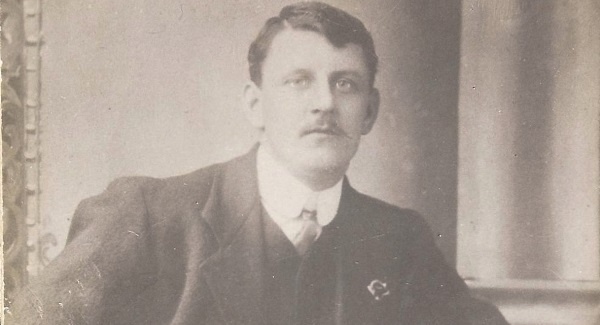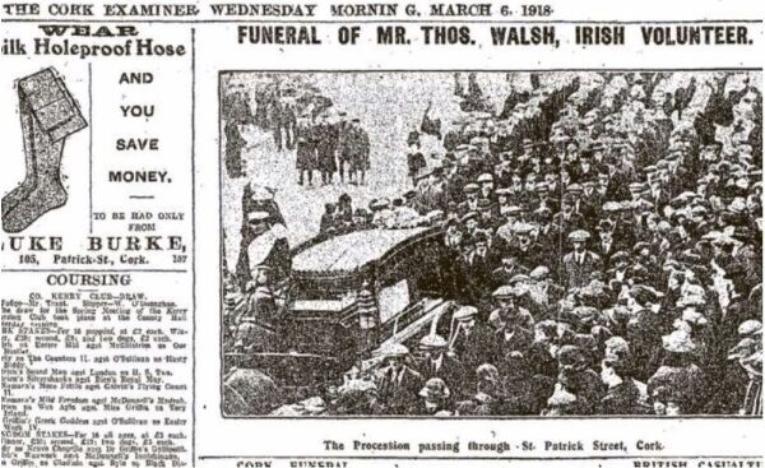In This Section
- Home
- Collections
- Atlas Resources for Schools
- Cork Fatality Register
- Mapping the Irish Revolution
- Mapping IRA Companies, July 1921-July 1922
- Mapping the Burning of Cork, 11-12 December 1920
- Martial Law, December 1920
- The IRA at War
- The Railway Workers’ Munitions Strike of 1920
- The Victory of Sinn Féin: The 1920 Local Elections
- The War of Words: Propaganda and Moral Force
- The IRA Offensive against the RIC, 1920
- De Valera’s American Tour, 1919-1920
- The British Reprisal Strategy and its Impact
- Cumann na mBan and the War of Independence
- The War Escalates, November 1920
- The War of Independence in Cork and Kerry
- The Story of 1916
- A 1916 Diary
- January 9-15 1916
- January 10-16, 1916
- January 17-23, 1916
- January 24-30, 1916
- February 1-6 1916
- February 7-14, 1916
- February 15-21, 1916
- February 22-27, 1916
- February 28-March 3, 1916
- March 6-13,1916
- March 14-20, 1916
- March 21-27 1916
- April 3-9, 1916
- April 10-16, 1916
- April 17-21,1916
- May 22-28 1916
- May 29-June 4 1916
- June 12-18 1916
- June 19-25 1916
- June 26-July 2 1916
- July 3-9 1916
- July 11-16 1916
- July 17-22 1916
- July 24-30 1916
- July 31- August 7,1916
- August 7-13 1916
- August 15-21 1916
- August 22-29 1916
- August 29-September 5 1916
- September 5-11, 1916
- September 12-18, 1916
- September 19-25, 1916
- September 26-October 2, 1916
- October 3-9, 1916
- October 10-16, 1916
- October 17-23, 1916
- October 24-31, 1916
- November 1-16, 1916
- November 7-13, 1916
- November 14-20, 1916
- November 21-27-1916
- November 28-December 4, 1916
- December 5-11, 1916
- December 12-19, 1916
- December 19-25, 1916
- December 26-January 3, 1916
- Cork's Historic Newspapers
- Feature Articles
- News and Events
- UCC's Civil War Centenary Programme
- Irish Civil War National Conference 15-18 June 2022
- Irish Civil War Fatalities Project
- Research Findings
- Explore the Fatalities Map
- Civil War Fatalities in Dublin
- Civil War Fatalities in Limerick
- Civil War Fatalities in Kerry
- Civil War Fatalities in Clare
- Civil War Fatalities in Cork
- Civil War Fatalities in the Northern Ireland
- Civil War Fatalities in Sligo
- Civil War Fatalities in Donegal
- Civil War Fatalities in Wexford
- Civil War Fatalities in Mayo
- Civil War Fatalities in Tipperary
- Military Archives National Army Fatalities Roll, 1922 – 1923
- Fatalities Index
- About the Project (home)
- The Irish Revolution (Main site)
The Corkman who fired the first shot of 1916

Thomas Walsh of the Irish Citizen Army will be remembered at a ceremony in his native city next weekend, writes Niall Murray
A memorial to Thomas “Corkie” Walsh will be unveiled on Sunday in the same graveyard as his better-known brother-in-law, the city’s first republican Lord Mayor, Tomás MacCurtain.
As a mason who served his apprenticeship in his native city before moving to Dublin, the monument to Walsh is being erected by a committee formed from the Cork Masons Historical Society in conjunction with the MacCurtain and Walsh families.
He had only been in Dublin around a year before he joined James Connolly’s Irish Citizen Army in 1915.
It was while manning a freshly-erected barricade in the earliest stages of the Rising on Easter Monday 1916 that Walsh was recognised by a group of friends.
In order to stop them mocking him with his “Corkie” nickname and kicking his barricade close to the GPO, he fired a shot in the air to get rid of them before any shots had been fired in anger.
The story recounted by Fionnuala MacCurtain in her book about her own grandfather Tomás was seen by Cork Masons Historical Society officer Jim Fahy.
“I had never heard about him before but when I read this I went looking through our records to find out more, and got in contact with counterparts in Dublin,” he explained.
“It was arising from that, and through contact with the family, that we decided to do something to mark the centenary of his death in 1918,” said Mr Fahy.
Thomas Walsh had been in the Cork branch of the Ancient Guild of Incorporated Brick, Block and Stone Mason’s Society, and became a member in Dublin when he moved. The Dublin branch sent money to his sisters back in Cork while he was detained in an English jail, and later at the Frongoch prison camp in Wales, following the Rising.
He had been captured along with other Citizen Army members fighting out of City Hall on the Tuesday of the Rising. Like many other participants, he was sentenced to death, but had that commuted to 10 years penal servitude.
He was released along with many others after a few months, returning to his lodgings in Cuffe Street near the Bricklayers’ Hall. But he died of cardiac failure and pneumonia less than two years later, after being brought from his lodgings to St Vincent’s Hospital on March 2, 1918.
Huge crowds turned out for his funeral in Cork, where local Irish Volunteers fired a volley over his grave at St Finbarr’s Cemetery. The funeral was the subject of a photograph and report seen by readers of the Cork Examiner on the same morning that news broke of the death of Irish Parliamentary Party leader John Redmond.

The Volunteers in Cork were under the command of Tomás MacCurtain whose wife Liz was one of the chief mourners, as Corkie Walsh was her brother. The couple met through the Irish-Ireland movement and meetings of the Gaelic League in Cork’s Blackpool suburb, but Tomás would be shot dead by police at their home there just over two years later as the city became a violent epicentre of the War of Independence.
The couple’s grand-daughter Fionnuala MacCurtain said that people do not always realise that the Irish cultural leanings of the family were more from Tomás’s side, whereas it was her grandmother’s Walsh family had a stronger Fenian background. Many had been involved in the 1867 Fenian Rising, some having to go to the United States afterwards, influences that might have been a factor in Thomas Walsh’s participation in the Irish Citizen Army.
The limestone memorial at his grave, carved by local mason Tom McCarthy, features the Irish Citizen Army’s Starry Plough emblem. Along with Deputy Lord Mayor Fergal Dennehy, the graveside unveiling at 1pm on Sunday will be addressed by James Connolly Heron, great-grandson of Irish Citizen Army leader and signatory of the 1916 Proclamation James Connolly.
A lecture by local historian Luke Dineen, who has been researching the life of Thomas ‘Corkie’ Walsh is open to the public on Saturday night at the Carpenters Hall on Cork’s Fr Mathew Quay.
This article was first published in the Irish Examiner on 26 February 2018
